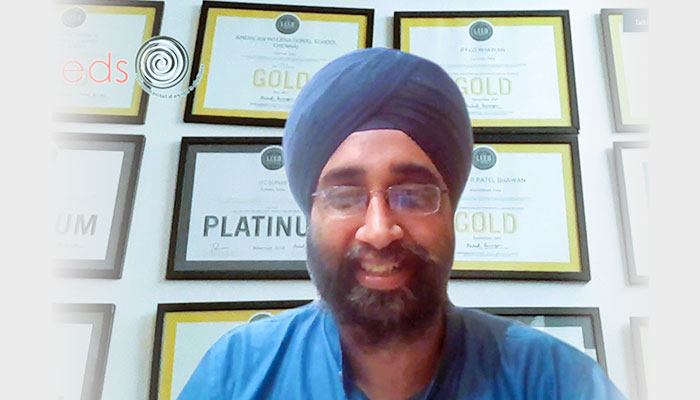What happens when you hardwire computational skills into the soul of an architect? You get Gurneet Singh, a IIIT Hyderabad alumnus who specializes in sustainability in the built environment, with a push towards resilient and low carbon development.
Way back in 2002, when IIIT Hyderabad started a bridge program between pure technology and building design, it was probably amongst the first in India to offer a course in simulation, analytics and building automation. The 2-year Master’s degree was the brainchild of Prof. Vishal Garg and IIITH’s Centre for Building Studies. The whole idea was to bring information technology into the design of environmentally responsive buildings. Gurneet was in the second batch of the curated M.Tech program before it was converted into a research-focused Master’s course.
As Director of Environmental Design Solutions (EDS), Gurneet specializes in Integrated Building Design, using simulation tools to assist in the design and delivery of energy efficient buildings. He has led the design and development of several plug-in/add on software evaluation tools for policy makers, manufacturers, rating and lending agencies. He has also developed training curricula and conducted training programs for India’s energy code (Energy Conservation Building Code –ECBC), advanced daylight analysis, passive solar design, advanced whole building performance diagnostics tools and high-performance buildings.
A career thanks to IIITH
“My career in this field is because of the exposure I got at IIITH”, says Gurneet. It was at a conference at IIITH that the young architect met Tanmay Tathagat, co-founder of EDS and a well-known name in the field of sustainability, who had worked in a similar domain in the USA. He was impressed with the research the institution was doing and offered Gurneet a role as an Analyst in their start-up venture.
Today, with over 500 green building and energy efficiency projects worldwide, the sustainability consulting firm provides inputs to design teams and project owners of infrastructure projects. They focus on various aspects of environmentally conscious building design, energy, water, and waste management. “Our expertise is in the energy sector policy and regulatory implementations. We do techno-economic feasibility studies, energy performance contracting projects, LEED and GRIHA certification and ESG projects, explains Gurneet. “We work closely with bilateral and multilateral organizations like USAID, GIZ, ADB, UNDP and World Bank.
Innovation in a project drives Gurneet. Whether it is building low energy-utilizing cooling systems by running chilled water through embedded pipes beneath the flooring slabs for Infosys Hyderabad or an institutional project for IIT Jodhpur, the entire planning is done, keeping in mind climate and topography or mainstreaming Thermal Comfort and Resource Efficiency in affordable housing. The Nirlon Knowledge Park in Mumbai and the greenfield T3 Terminal at Delhi International airport are instances of scaling the model to reduce environmental impact while incorporating site features and optimizing building performance.

The IIITH Edge
“I strongly believe that whatever happens, is for the best”, observes Gurneet. “That has been the biggest influencer in my life. I have never planned anything in my life and go with the flow.” Looking back, Gurneet traces his interest in programming, to the CAD tools that they were exposed to, in the fourth year of his B.Arch. program at the Chandigarh college of architecture. It was IIITH’s newspaper advertisement for the curated IT course that his brother happened to show him, that brought Gurneet to the verdant campus.
The automation of performance evaluation processes that he specializes in, is a direct outcome of his 2-year stint at IIITH, maintains Gurneet. “Ours was the second batch of 10 architects and civil engineers. At that time, the course was new and there was no college that was even thinking close to what this course was offering. Green buildings were just evolving and the first building in India was certified in 2001. I worked on the second building in India, when I joined EDS.” The best part of being in the early batch was that Prof. Vishal Garg gave his students the flexibility to modify the course. “I was fortunate to learn from stalwarts; database from Dr. Kamal Karlapalem, computer graphics from Dr. P J Narayanan, Dr. Dwarak and Dr. Govindaraju”, says the sustainability expert. “We were lucky to share a common Lab with the Computer Science M.Tech batch and we learnt a lot from them”.
At IIITH, Gurneet had the opportunity to work on various automation projects and was involved in conducting workshops and training programs for external participants. One interesting project that was ahead of its time was an automation project for controlling different devices through a mobile phone / keypad. This was in 2003, in a time before smart phones or bluetooth gadgets were available. “It was a challenging project that involved programming, soldering parts and creating circuits. We were lucky that Sam Babu was with us on our project, and we could learn a lot from him” says Gurneet.
Canteen coffee, birthdays and a backdrop
Some of Gurneet’s fondest IIITH memories revolve around the campus canteens, whether it was the good-natured roasting at birthday parties at the canteen or learning Telugu numbers by the coffee machine. He recalls that in 2002, the Gachibowli area was still remote, and wilderness surrounded the campus. Around that time, the IIITH student community was expanding and becoming diverse. One of the first changes in the canteen was a menu overhaul and the introduction of pindi-chole, rajma-chawal and a good representation of north Indian cuisine in the diet chart!
Coming from a small batch of non-IT students, it was a different experience for the youngster. But his design background was put to effective use by the creative team. “IIITH gave me the opportunity to design a backdrop for one event, which I think is still in use”, muses Gurneet. “I found some pictures on Facebook where the same backdrop was used during some recent events”.

Life, Love and Building a sustainable lifestyle
Gurneet pegs himself as a true Piscean, whose chief extracurricular activity is either catching up on his beauty sleep or an early morning workout in an open gym.
It’s a perfect combination of design and technology in the Singh household. “My father was an architect, my mother was a physics teacher and my wife is a professor of mathematics. My children will be a combination of design and math. One of the biggest influences in my life was my mother, whose passion for math and numbers influenced me. Another big impact in my life is her belief in God’, remarks Gurneet.
Gurneet puts a lot of weightage on integrity in the workplace along with discipline, dedication and delivering quality work. “I’m lucky that Tanmay and Anamika brought the western work culture of always putting the employee first. From the very first day at EDS, I worked in a great environment that helped me in maintaining a work life balance”.
While extending an invitation for internships in his company, Gurneet observes that there’s a huge potential to work with teams to optimize the operation and design. I would love to come back to IIIT Hyderabad as guest faculty anytime”, says Gurneet who believes that when working professionals like him share their experiences on real life projects, it bridges the gap between theoretical and practical knowledge.



Next post